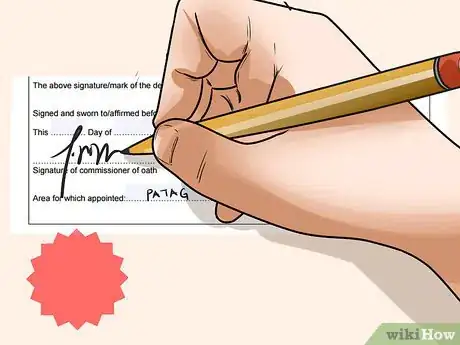This article was written by Jennifer Mueller, JD. Jennifer Mueller is an in-house legal expert at wikiHow. Jennifer reviews, fact-checks, and evaluates wikiHow's legal content to ensure thoroughness and accuracy. She received her JD from Indiana University Maurer School of Law in 2006.
This article has been viewed 115,457 times.
If you have a friend or relative involved in a contested custody case, they may ask you for a character affidavit. You would provide sworn testimony under penalty of perjury about things you have witnessed regarding their moral and ethical character. Instead of testifying in court, you would be writing down your testimony and signing it. You can draft the affidavit yourself, or an attorney may want to do it for you.
Steps
Signing an Affidavit Prepared for You
-
1Understand why your affidavit is needed and how it will be used. Before you agree to provide an affidavit, learn what facts are at issue in the case that make an affidavit necessary.
- Make sure you're not being asked to say something that you don't believe or to testify to facts you haven't observed. If it can be proven that you lied in an affidavit, you can be prosecuted for perjury.
- Since the affidavit will be filed as part of the case, it will become a public record that anyone can access later. A copy also will be provided to the other side in the custody dispute.
- Find out the issues involved. You know that custody is being contested. You should also understand why, so you can stick to the facts that will be relevant to resolving the contested issues. For example, if custody is contested because one parent claims the other is an alcoholic, any information included in your affidavit should focus on that issue. If you introduce extraneous matters, you're wasting the court's time. [1]
-
2Talk to the attorney who will draft the affidavit. The attorney may want to interview you personally regarding your observations, or s/he may ask you simply to write them down. In the latter case s/he may follow up with questions later if s/he needs more information.
- Depending on what you say, the attorney may ask you for supporting documents or other evidence to corroborate your statement. [2] For example, suppose you're the child's baseball coach and you're discussing the parent's involvement in the child's activities. You mention that the parent often kept score at games. The attorney might ask to see score sheets his client completed.
Advertisement -
3Review the statements written in the affidavit. The attorney may omit any hyperbole or melodramatic statements you make and may change your wording a bit to suit legal style and format. The affidavit should include only observations you have previously discussed with the attorney.
-
4Provide suggestions for revision if necessary. You are signing your affidavit under oath and penalty of perjury, so if there's anything there that you're not 100 percent comfortable saying, you shouldn't sign the affidavit until it's corrected so that you completely agree with it.
-
5Sign the affidavit in the presence of a notary. To be valid in a court of law, affidavits must be witnessed by a notary public licensed in your state.
- Since an attorney has drafted your affidavit, s/he probably will provide a notary public and arrange for you to sign your affidavit, usually in the attorney's office.
-
6Appear in court if necessary. Affidavits often are used to establish custody temporarily. However, if your statements are to be used to help make a permanent custody arrangement, you will probably be required to testify in open court. [3]
Drafting the Affidavit Yourself
-
1Understand the purpose of your affidavit. Before you begin to write anything down, make sure you understand what issues are in dispute and why you've been called on to provide supporting evidence.
- You need to know this so you can include in the affidavit only relevant information. If your observations are not relevant to anything at issue in the case, they won't be admissible.
- For example, suppose your friend's custody of her child is being challenged by the child's father, who alleges that your friend is abusive. Focus in the affidavit on observations you've made that tend to demonstrate your friend is not abusive to her child. [4]
-
2Check for affidavit forms. Some states provide affidavit forms, also called "declarations." You can use such a form for formatting purposes, but you'll have to adapt it to suit your own needs. [5]
-
3Create the caption.
- The heading information at the top of the first page of the affidavit is called the "caption." Usually it includes the name of the court, the names of the parties, and the case number.
- The content and format of the caption should remain the same in all documents filed in the case. Thus you could simply copy the caption of one of the other documents. [6]
-
4Title your affidavit. Drop two lines below the caption, and type a title such as "Affidavit of [Your Name]," or simply "Character Affidavit."
- Use a previously filed document in the case as a guide for how to format the title, as document-formatting preferences differ from one court to the next. Generally, titles are centered and in bold-face type. Some courts prefer the title to be in all capital letters or underlined.
-
5Identify yourself and your relationship to the party in the case. Start the body of your affidavit by introducing yourself to the court. [7]
- You may use traditional, formal court language if you prefer, which is "Comes now [your name], a nonparty, and states as follows:" followed by numbered statements.
- Each numbered statement typically covers one subject. It may be one sentence or several.
- Make a statement regarding your belief that the person for whom you're writing the affidavit has a good moral and ethical character.
-
6Describe your background. Explain to the court who you are and any part of your background or experience that makes you a credible witness. [8]
- For example, if you are the child's baseball coach and have observed the parent interact with the child at games and practices, you might mention how long you've been a youth baseball coach and approximately how many other parent-child relationships you've observed.
-
7Write about your observations. Give specific, numbered examples of things you've personally observed that demonstrate and support your belief about the person's character.
- Follow the general writing advice: "show, don't tell." Show the court specific facts or instances that illustrate the good character of the person, rather than simply saying the person has a good reputation, or that in your opinion s/he has strong morals.
- Stay away from vague statements such as "Dad is an actively involved parent." Instead, provide specific instances of Dad's active involvement. For example, if you're the child's baseball coach, you might mention that Dad comes to every practice and every game and also helps the team in the dugout. [9]
- Be cautious of citing facts that might not be seen as demonstrating good moral character. For example, you may believe that active membership in a church is evidence of good moral character, but that would not necessarily be persuasive evidence in the eyes of someone of a different spiritual temperament.
- Be objective. Rather than setting forth church membership as evidence of character, talk about the things the person did through the church. For example, building a house for a needy family or operating a canned-food drive might be seen as indicating good character.
- Try your best to remain balanced. If you know of positive attributes of the other parent, include that information, too. Entirely one-sided affidavits may raise suspicions. [10]
- Avoid trying to make the person look like a saint. Nobody's perfect. If you list only positive and glowing traits of your friend, your affidavit won't be very credible. If you know of weaknesses, include those as well. It will make your affidavit more persuasive. [11]
- For example, suppose the child's father alleges that the child's mother, your friend, is an alcoholic. If you know that she sometimes drinks, occasionally to excess, you should include that information. Doing so will lend authenticity to your statement. Remember that you are writing your affidavit under oath.
-
8Format your signature block. When you've finished saying everything you want to say, drop down two lines and lay out the area where you'll sign your affidavit.
- Include a statement such as "I swear the information contained above is true and correct to the best of my knowledge and belief."
- Leave enough space beneath the above statement for your signature and date. Under that, type your name, address, telephone number, and email address.
-
9Add a notary block. Affidavits must be signed in the presence of a notary public, who also must sign the affidavit as a witness and affix a seal.
- The exact format and space needed for a notary block vary from state to state. Search online to find the form you need for your state, and then copy it onto your affidavit. [12]
-
10Sign your affidavit in the presence of a notary. Find a notary public near you, and make arrangements to sign your affidavit in their presence.
- Many banks have a notary available to their customers for free. You can also find a notary service at some private businesses such as check-cashing companies, or at your local courthouse. These notaries typically charge a small fee for their services.
-
11Make a copy of your signed affidavit. The person who requested the affidavit will need the original to file with the court, but make sure you have a copy for your own records before you hand it over.
-
12Appear in court if necessary. Some family-court judges will want you to appear in court and testify on the stand to the facts stated in your affidavit. Although they may rely on affidavits for temporary decisions, they might want to see you in person before any permanent order is made. [13]
References
- ↑ http://www.gregoryforman.com/faqs/how-does-one-draft-an-affidavit/
- ↑ http://www.gregoryforman.com/faqs/how-does-one-draft-an-affidavit/
- ↑ http://www.iowalegalaid.org/resource/affidavits
- ↑ http://www.gregoryforman.com/faqs/how-does-one-draft-an-affidavit/
- ↑ http://family.findlaw.com/child-custody/child-custody-forms-by-state.html/
- ↑ http://definitions.uslegal.com/c/caption/
- ↑ http://www.gregoryforman.com/faqs/how-does-one-draft-an-affidavit/
- ↑ http://www.gregoryforman.com/faqs/how-does-one-draft-an-affidavit/
- ↑ http://www.gregoryforman.com/faqs/how-does-one-draft-an-affidavit/
About This Article
Before you sign an affidavit form, talk to your friend or relative to ensure you understand the issue at hand. Next, check to see if your state provides an affidavit form, which can be used as a template for your letter. As you write your affidavit, include specific examples of good character, such as the person’s roles in the community or as a parent. When you’re finished, don’t forget to get your affidavit signed by a notary, and make a copy for your records. To learn how to work with an attorney to draft an affidavit, read more from our Legal co-author.













































































